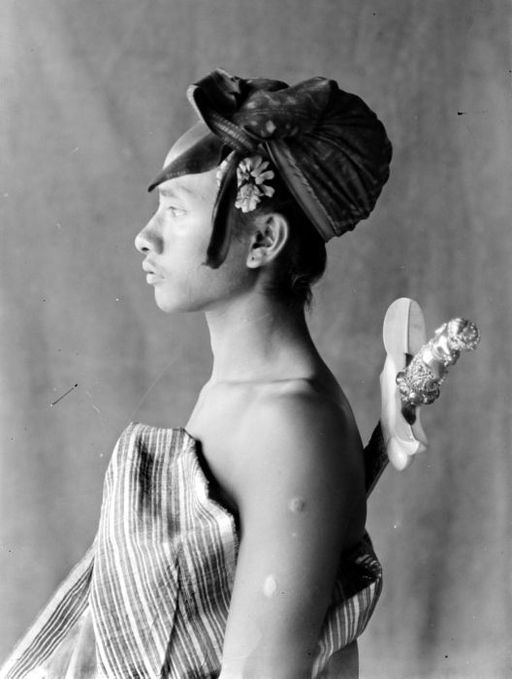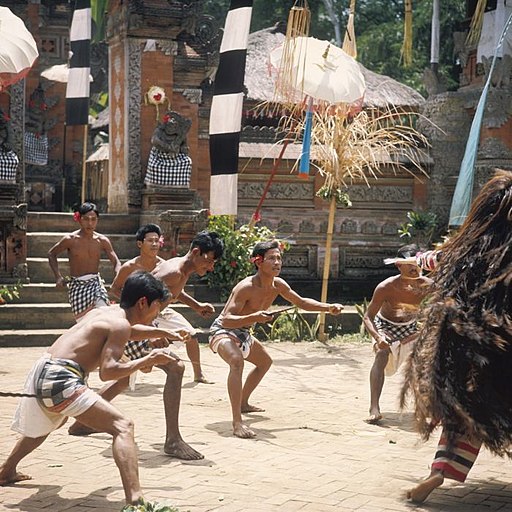Balinese Kris: Types, Symbolism, and Where to Find Them
The Balinese Kris, also known as Keris, is an iconic and culturally significant weapon in Bali. It holds a prominent place in Balinese folklore, rituals, and traditional ceremonies. The Kris is not just a weapon; it is considered a sacred object that embodies spiritual and mystical qualities.
Exploring the captivating world of Balinese Kris. Delve into their diverse types, symbolic meanings, and experience the allure of these extraordinary blades as you connect with the enchanting culture of Bali.
The Balinese Kris is a distinctive dagger with a wavy blade that represents the cosmic forces of nature. Its intricate design reflects the artistic craftsmanship and deep symbolism embedded within Balinese culture. Each Kris is meticulously handcrafted, featuring elaborate carvings, precious metals, and gemstones.

Balinese Kris with case or scabbard, decorated with demon head. Tropenmuseum, part of the National Museum of World Cultures, CC BY-SA 3.0, via Wikimedia Commons
The noble value of a keris
Originally, the Keris was a traditional weapon, but its significance has extended far beyond its martial origins. The Keris holds various roles and symbolic meanings in Balinese culture. It is revered as a sacred item, an object of worship, a symbol of family ties, a mark of service and position, a luxurious item, and a remarkable work of art. It encompasses the disciplines of forging, carving, sculpture, form, and symbolism, making it a masterpiece of craftsmanship.
Keris is made primarily as an heirloom or sipat kandel, which is believed to protect and ensure the owner’s safety and well-being. Indonesian keris has been recognized as a World Heritage by UNESCO in 2005. This is based on the invisible value that exists on a keris. For example aspects of philosophy, symbols, history, traditions and others that are not owned by other sharp weapons from around the world.
This recognition is due to the intrinsic and intangible values embedded within the Keris. Its philosophy, symbols, history, traditions, and other unique aspects set it apart from other sharp weapons found around the world.
Whether displayed as a treasured artifact or worn as a symbol of prestige and protection, the Keris serves as a powerful reminder of the noble values and profound traditions that shape Balinese culture. Its beauty and historical significance continue to captivate collectors, enthusiasts, and those who appreciate the intricacies of Balinese artistry.
Hindu Gods and Goddesses in Bali | A Guide to the Most Important Deities
Mythology and history
The Kris holds a special place in Balinese mythology and history. It is believed to possess supernatural powers and protect its owner from evil spirits. The blade of the Kris is often associated with mythical creatures, deities, and ancestral spirits, further adding to its mystique.
Beyond its ceremonial and symbolic significance, the Kris is also appreciated as a work of art. Collectors and enthusiasts value the craftsmanship, rarity, and historical importance of antique Kris blades. These intricate weapons are sought after for their beauty, cultural significance, and the stories they hold.
Local culture
In Bali, the Kris continues to be revered and cherished. It is often displayed in temples, royal palaces, and cultural exhibitions. The ritualistic use of the Kris in traditional Balinese dances and ceremonies further highlights its importance in the local culture.

Balinese wearing a kriss (1910-1920). Tropenmuseum, part of the National Museum of World Cultures, CC BY-SA 3.0, via Wikimedia Commons
The Balinese Kris serves as a tangible link to Bali’s rich history, traditions, and spiritual beliefs. It symbolizes strength, honor, and protection. Its captivating design and deep-rooted cultural significance make it a truly remarkable artifact.
Whether admired for its artistic beauty or revered for its spiritual significance, the Balinese Kris stands as a testament to the artistic and cultural heritage of Bali. It invites us to explore the captivating world of Balinese traditions, rituals, and the intricate craftsmanship that has been passed down through generations.
As you delve into the realm of Balinese culture, take a moment to appreciate the timeless allure of the Balinese Kris and the stories it carries from the past into the present.

Kris between 1500 and 1900. Place of manufacture: Bali. Description: Kris, steel blade, wooden scabbard and housing, ivory handle. Crosspiece is painted. One side with flowers and arabesques, the other side with figures. Rijksmuseum, CC0, via Wikimedia Commons
Types of Balinese Kris
The Balinese Kris comes in different types, each with its own distinct characteristics. Some notable types include:
- Luk (bend) or Straight Kris: This type features a straight blade with minimal curvature, known for its simplicity and elegance, , showcasing the Balinese craftsmanship in its purest form.
- Miring or Wavy Kris: This is the most common type of Balinese Kris, characterized by its distinctive wavy blade. The waves symbolize the cosmic forces of nature and are believed to enhance the spiritual and magical properties of the Kris.
- Ganja or Handle: The Kris handle, known as Ganja, is a work of art in itself. The handle of the Kris is intricately crafted and often showcases intricate carvings of mythological figures or sacred symbols.
- Pamor or Blade Patterns: The blade of the Kris is adorned with intricate patterns known as pamor. These patterns are created through a process of layering different types of iron and steel, resulting in stunning visual effects.
- Kris Naga: The Kris Naga features a wavy blade with intricate serpent-like patterns, representing the mythical Naga, a serpent or dragon often associated with water and fertility. It is considered a symbol of protection and prosperity.
- Kris Sajen: The Kris Sajen is not meant for combat. Instead, it is a ritualistic Kris used for offerings and ceremonies. It is adorned with various symbolic objects and materials, making it an essential tool for spiritual rituals.

Kedutan (Kris), with holder. In the island of Bali it is called kadutan or kudutan. Keris is also called duwung, tappi, selle, gayang, kres, kris, karieh, and others. Tropenmuseum, part of the National Museum of World Cultures, CC BY-SA 3.0, via Wikimedia Commons
Ceremonial Balinese kris
Ceremonial Balinese kris, the blade of which is made in pamor and contains 13 bends. The blade base is shaped like a lizard. The handle is made of gold and depicts the god Rawana, who holds a sword in his right hand. The handle is set with various stones of presumably colored glass. According to van Duuren, such krises with inlays of precious stones are royal krises.
The sheath is made of wood and is enclosed by a silver sheath, which also contains decorative stones on the top. In Bali, the kris has a sacred connotation, for it is secti, a manifestation of a cosmic force in specific form. Offerings are made before and during the forging of kris, and when the kris is finished it is consecrated by a small ritual. At set times the kris are worshiped in the privacy of the family.
The Balinese will never call his kris that; he refers to it as kedutan, “beauty of my girdle”.. Iron kris with golden ornaments and silver scabbard or case.

Iron kris with gold handle and silver socket or case. Tropenmuseum, part of the National Museum of World Cultures, CC BY-SA 3.0, via Wikimedia Commons
Where to see and buy?
To explore the world of Balinese Kris, you can visit various cultural centers, museums, and art galleries in Bali. Places such as the Bali Museum in Denpasar, the Agung Rai Museum of Art in Ubud, and the Puri Lukisan Museum in Ubud showcase exquisite collections of Balinese Kris, providing insights into their history and significance.
If you wish to acquire a Balinese Kris for yourself, you can explore reputable antique shops, art markets, and specialized Kris galleries in Bali. These establishments offer a wide range of Kris blades, both antique and newly crafted, allowing you to find a piece that resonates with your interests and appreciation for Balinese culture.
It’s important to note that the Balinese Kris is not merely a decorative item but a culturally significant artifact. Therefore, when acquiring a Kris, it is advisable to seek guidance from knowledgeable experts or collectors to ensure authenticity and a deeper understanding of its cultural context.

Barong dance performance with kris dancers and Rangda (the demon queen of the Leyaks in Bali, according to traditional Balinese mythology. Terrifying to behold, the child-eating Rangda leads an army of evil witches against the leader of the forces of good — Barong). Tropenmuseum, part of the National Museum of World Cultures, CC BY-SA 3.0, via Wikimedia Commons
Photo credit: Artist: Unknown author. Kriss between 15th century and 17th century in Historical Museum of Bern, CC BY-SA 2.0 FR, via Wikimedia Commons. Website: https://www.bhm.ch
Bali Souvenirs | What to Bring Back from Bali: Unique Souvenirs and Treasures
Have you booked your villa in Seminyak center?
Located in Seminyak Center – Bali, Villa Carissa offers a private swimming pool and enclosed garden to guarantee your privacy. You can book your private pool villa here with us.
Whether you’re traveling with family, friends, or on a romantic getaway, villa Carissa in Seminyak center offers the perfect base for exploring Bali’s many attractions and enjoying a relaxing vacation.


What makes the Balinese Kris (Dagger) such an intriguing cultural symbol, and how has it evolved over time to represent power, mystique, and heritage in Balinese society?
The Balinese Kris, a traditional dagger, is more than just a weapon; it’s a symbol of Balinese heritage and mystique.
With intricate designs and craftsmanship, each Kris carries its own unique history and significance.
Believed to possess supernatural powers, it’s revered for its ability to ward off evil and protect its owner.
Once worn by nobility, it now holds cultural significance in ceremonies and performances, representing Balinese tradition and prestige.